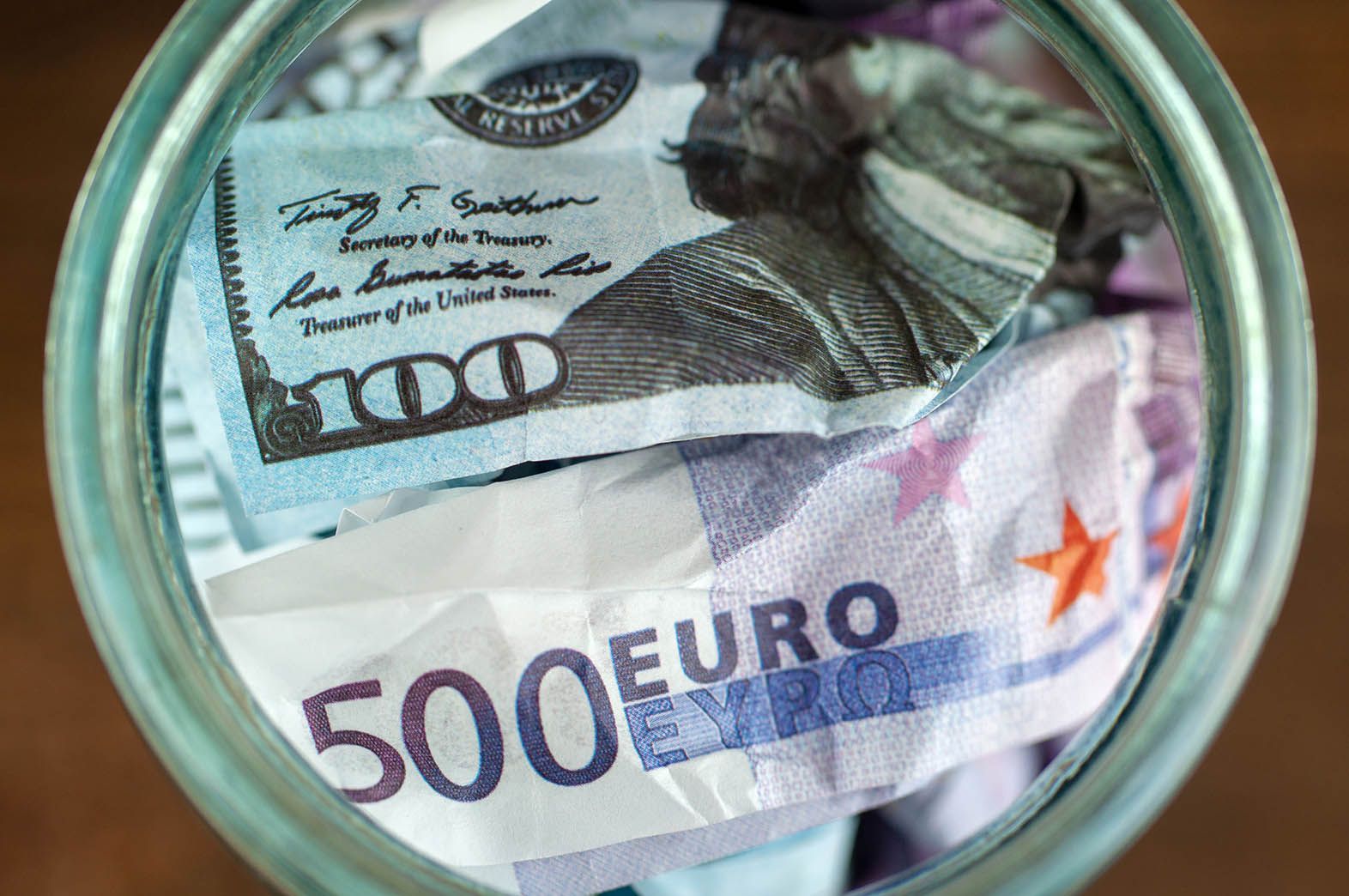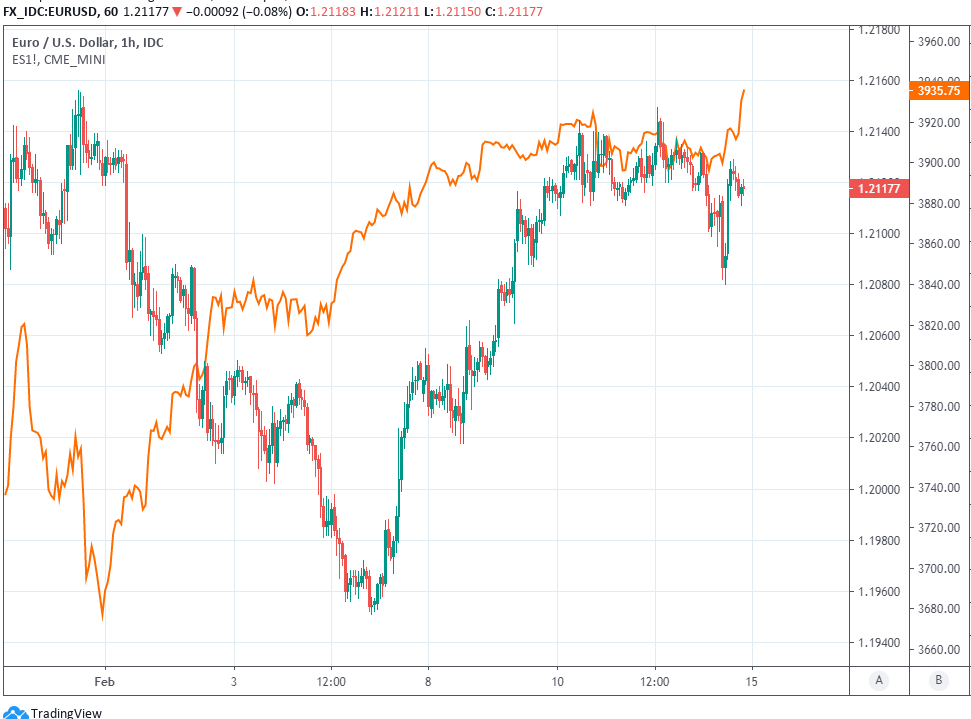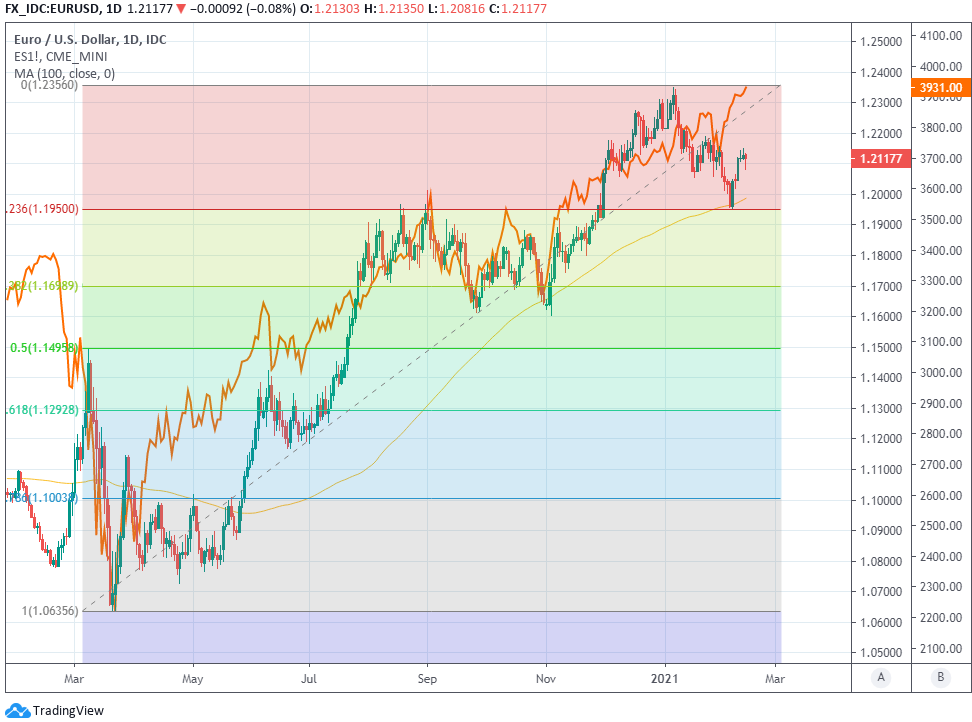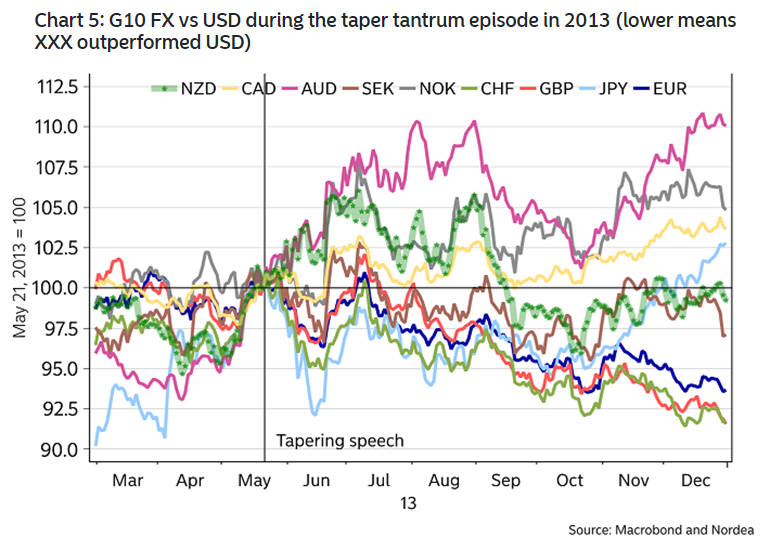Euro-Dollar Week Ahead Forecast: Range-trading with Support at 1.1960 and Upside Risks
- Written by: James Skinner
- EUR/USD supported at 1.1945 after January's wobble.
- But faces resistance near 1.22, near-term range-trade.
- New risk relationship hints EUR now 'risk-off' currency.

Image © Adobe Images
- EUR/USD spot rate at time of writing: 1.2121
- Bank transfer rate (indicative guide): 1.1697-1.1782
- FX specialist providers (indicative guide): 1.1939-1.2036
- More information on FX specialist rates here
The Euro-to-Dollar exchange rate has stabilised and is now trading a narrow range with upside risks following its January wobble, although the Euro will have to contend with a series of key data points and minutes from meetings of both the European Central Bank (ECB) and Federal Reserve (Fed) this week.
Europe's single currency consolidated its recovery of the 1.20 handle last week after profit-taking brought it within inches of unravelling beneath it in the dying days of January, with its stabilisation following gains in other European currencies that have reduced the overall trade-weighted Euro.
Perhaps most frustratingly for many regular observers, the Euro's relationship with stock markets and other risk assets has turned on its head, with EUR/USD now falling in response to upward moves in equity markets and rising in response to so-called 'risk off' trading conditions.
This is effectively a warning of how the Euro-to-Dollar exchange rate could behave in the instance where there is lots of crashing and banging in stock markets, commodities and emerging market currencies. It's a strong indication that EUR/USD could rise in respons to such market conditions rather than fall as it has so often in the recent past.
"EUR/USD has been trading very narrow ranges over recent days and that may continue through the early part of week. Pressure may emerge around the release of the FOMC minutes, but perhaps 1.2050 might be enough of a correction," says Petr Krpata, chief EMEA strategist for FX and bonds at ING. 
Above: Euro-to-Dollar rate shown at hourly intervals alongside S&P 500 index futures (orange).
"EUR/USD is probing the 50% retracement at 1.2151 and directly above here lies the 1.2190 22nd January high. The market is consolidating here, and we suspect that these are likely to act as the barrier to the 1.2556 2018 high," says Karen Jones, head of technical analysis for currencies, commodities and bonds at Commerzbank. "Given that Fridays price action was just about a key day reversal, the near term risk is shifting to the topside."
Jones says the Euro-to-Dollar rate should now find support around 1.1945 in response to any weakness.
European currencies have proven to be popular expressions of the reflation trade over recent weeks, although the Euro itself has lagged behind owing in part to ECB concerns about the pace of its earlier rally. Gains elsewhere in the European FX market have helped to ease the upward pressure on the trade-weighted (TWI) measures of the Euro, making space in the TWI for further EUR/USD gains, although appetite for the Euro will be tested this week by a series of important data and information releases in Europe and the U.S.
{wbamp-hide start} {wbamp-hide end}{wbamp-show start}{wbamp-show end}
The first test for the Euro comes from final quarter GDP data that is due out at 10:00 London time on Tuesday and consensus among economists indicates it is expected to reveal a --0.7% quarter-on-quarter decrease. Investors and traders will be most interested to see the data because of the new or otherwise tighter 'lockdown' that was imposed across the continent ahead of year-end, and in light of these economic shutdowns having been extended.
"On the minutes, the key focus will probably be the ECB’s reaction to EUR strength and whether it would choose more QE or depo rate cuts to address it. With the market somewhat desensitised to this debate and already toying with pricing a depo rate cut over the next twelve months, we doubt that this discussion in the minutes would have much impact on the EUR or money markets – but it’s certainly an event risk to brace for," ING's Krpata says.
Above: EUR/USD at daily intervals with Fibonacci retracements of 2020 rally and S&P 500 index futures (orange).
With international developments aside, arguably the most significant this week are the release of minutes from the recent meeting of the ECB's Governing Council and Friday's flash PMI surveys of manufacturing and services sector activity. The ECB's monetary policy meeting account is set to be released at 12:30 on Thursday, while the PMI surveys are out between 08:15 and 10:00 on Friday and will provide an indication of how the continent's two largest sectors have fared thus far in the New Year.
"On our estimate is 1trn of added liquidity leads S&P 500 three percent higher," says Andreas Steno Larsen, chief FX strategist at Nordea Markets. "And with growth exploding, inflation surging, and a potential short-term melt-up in US assets due to a cascade of USD liquidity, is it not the most likely take-away that Powell’s team of cooing doves will have a harder and harder time facing down speculation of an early tapering by the Fed towards the end of Q2? We therefore took a look at what happened in the FX space during the infamous taper tantrum of 2013, which was triggered by then Fed Chair Bernanke’s speech in May. In the G10 FX space, the CHF, JPY, EUR & GBP fared generally well during this hot summer (for the FI space) while more “risky” currencies such as AUD, NOK and NZD did worse."
Elsewhere in the world and of note for the Euro, minutes of the January Federal Reserve meeting will be released at 19:00 on Wednesday and it's likely that investors will go through them with a fine toothed comb for clues about whether or not Chairman Jerome Powell's frequent assertions of unrelenting support for the economy are really and truly shared by all members of the Federal Open Market Committee of rate setters. Any suggestions they aren't could lead to increases in American bond yields, pressure on the stock markets and in light of the recent correlation change; a rally in EUR/USD.
With these short-term factors aside, the foremost influence on the Euro up ahead could well be the emerging story and building picture that suggests it's been a significant beneficiary of a central bank reserve diversification at the People's Bank of China, away from the U.S. Dollar.
Source: Nordea Markets.






